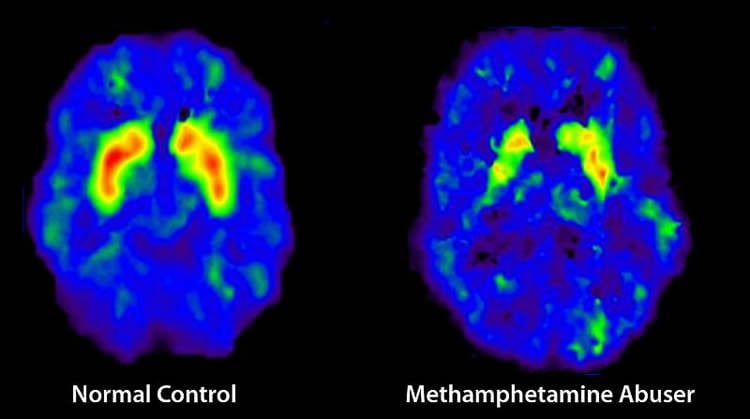Single injection of drug candidate prevents meth relapse in animal models.
Recovering addicts often grapple with the ghosts of their addiction–memories that tempt them to relapse even after rehabilitation and months, or even years, of drug-free living. Now, scientists from the Florida campus of The Scripps Research Institute (TSRI) have made a discovery that brings them closer to a new therapy based on selectively erasing these dangerous and tenacious drug-associated memories.
“We now have a viable target and by blocking that target, we can disrupt, and potentially erase, drug memories, leaving other memories intact,” said TSRI Associate Professor Courtney Miller. “The hope is that, when combined with traditional rehabilitation and abstinence therapies, we can reduce or eliminate relapse for meth users after a single treatment by taking away the power of an individual’s triggers.”
The new study, published this week online ahead of print by the journal Molecular Psychiatry, demonstrates the effectiveness of a single injection of an early drug candidate called blebbistatin in preventing relapse in animal models of methamphetamine addiction.
The new study builds on previous work in Miller’s lab. In 2013, the team made the surprising discovery that drug-associated memories could be selectively erased by targeting actin, the protein that provides the structural scaffold supporting memories in the brain. However, the therapeutic potential of the finding seemed limited by the problem that actin is critically important throughout the body–taking a pill that generally inhibits actin, even once, would likely be fatal.
In the new study, Miller and her colleagues report a major advance–the discovery of a safe route to selectively targeting brain actin through nonmuscle myosin II (NMII), a molecular motor that supports memory formation. To accomplish this, the researchers used a compound called blebbistatin that acts on this protein.
The results showed that a single injection of blebbistatin successfully disrupted long-term storage of drug-related memories–and blocked relapse for at least a month in animal models of methamphetamine addiction.

“What makes myosin II such an exciting therapeutic target is that a single injection of blebbistatin makes methamphetamine-associated memories go away, along with dendritic spines, the structures in the brain that store memory,” said Research Associate Erica Young, a member of the Miller lab and a key author of the new study, along with Research Associates Ashley M. Blouin and Sherri B. Briggs.
Blouin added, “Drugs targeting actin usually have to be delivered directly into the brain. But blebbistatin reaches the brain even when injected into the body’s periphery and, importantly, the animals remained healthy.”
Moreover, the effect of this novel treatment approach was specific to drug-associated memories (not affecting other memories), and the animals were still able to form new recollections.
“Our results argue for developing small molecule inhibitors of nonmuscle myosin II as potential therapeutics for relapse prevention, and that’s exactly what we’re doing with our colleagues here at Scripps with expertise in drug development,” said Briggs.
In addition to Miller, Young, Blouin and Briggs, other authors of the study, “Nonmuscle Myosin IIB as a Therapeutic Target for the Prevention of Relapse to Methamphetamine Use,” include Stephanie E. Sillivan, Michael D. Cameron and Gavin Rumbaugh of TSRI.
Funding: This work was supported by the National Institute on Drug Abuse (R01DA034116, R01DA034116S1 and R21DA036376), the National Institute for Neurological Disorders and Stroke (R01NS064079), the National Institute for Mental Health (R01MH096847) and the Brain and Behavior Research Foundation (NARSAD Young Investigator Awards).
Source: Scripps Research Institute
Image Source: The image is the NIH
Original Research: Abstract for “Nonmuscle myosin IIB as a therapeutic target for the prevention of relapse to methamphetamine use” by E J Young, A M Blouin, S B Briggs, S E Sillivan, L Lin, M D Cameron, G Rumbaugh & C A Miller in Molecular Psychiatry. Published online August 4 2015 doi:10.1038/mp.2015.103
Abstract
Nonmuscle myosin IIB as a therapeutic target for the prevention of relapse to methamphetamine use
Memories associated with drug use increase vulnerability to relapse in substance use disorder (SUD), and there are no pharmacotherapies for the prevention of relapse. Previously, we reported a promising finding that storage of memories associated with methamphetamine (METH), but not memories for fear or food reward, is vulnerable to disruption by actin depolymerization in the basolateral amygdala complex (BLC). However, actin is not a viable therapeutic target because of its numerous functions throughout the body. Here we report the discovery of a viable therapeutic target, nonmuscle myosin IIB (NMIIB), a molecular motor that supports memory by directly driving synaptic actin polymerization. A single intra-BLC treatment with Blebbistatin (Blebb), a small-molecule inhibitor of class II myosin isoforms, including NMIIB, produced a long-lasting disruption of context-induced drug seeking (at least 30 days). Further, postconsolidation genetic knockdown of Myh10, the heavy chain of the most highly expressed NMII in the BLC, was sufficient to produce METH-associated memory loss. Blebb was found to be highly brain penetrant. A single systemic injection of the compound selectively disrupted the storage of METH-associated memory and reversed the accompanying increase in BLC spine density. This effect was specific to METH-associated memory, as it had no effect on an auditory fear memory. The effect was also independent of retrieval, as METH-associated memory was disrupted 24 h after a single systemic injection of Blebb delivered in the home cage. Together, these results argue for the further development of small-molecule inhibitors of NMII as potential therapeutics for the prevention of SUD relapse triggered by drug associations.
“Psychological Effect of an Analogue Traumatic Event Reduced by Sleep Deprivation” by Kate Porcheret, PhD; Emily A. Holmes, PhD; Guy M. Goodwin, FMedSci; Russell G. Foster, PhD; and Katharina Wulff, PhD in Sleep. Published online July 1 2015 doi:10.5665/sleep.4802






